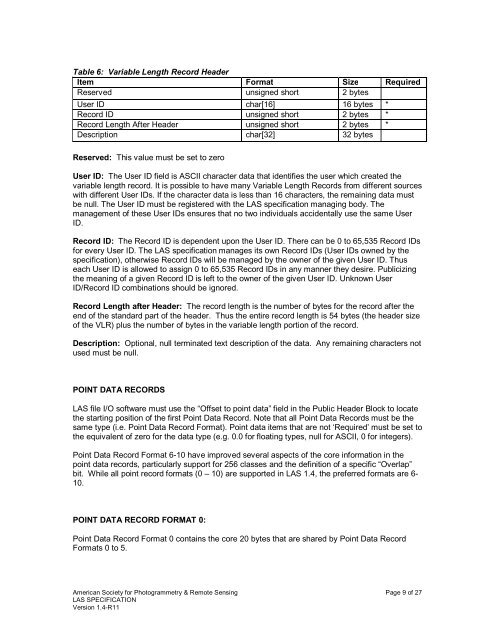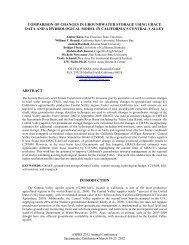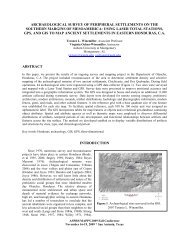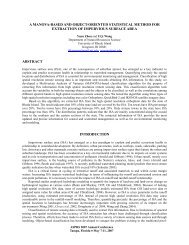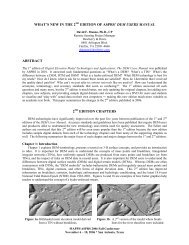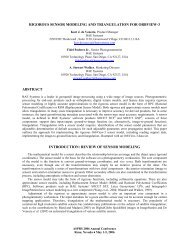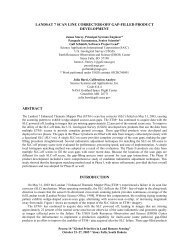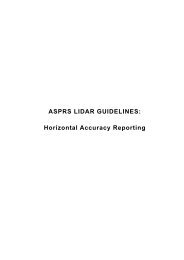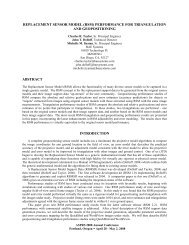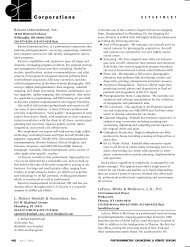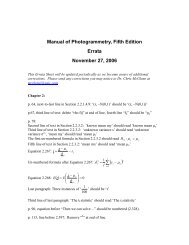LAS SPECIFICATION VERSION 1.4 – R11 - asprs
LAS SPECIFICATION VERSION 1.4 – R11 - asprs
LAS SPECIFICATION VERSION 1.4 – R11 - asprs
You also want an ePaper? Increase the reach of your titles
YUMPU automatically turns print PDFs into web optimized ePapers that Google loves.
Table 6: Variable Length Record Header<br />
Item Format Size Required<br />
Reserved unsigned short 2 bytes<br />
User ID char[16] 16 bytes *<br />
Record ID unsigned short 2 bytes *<br />
Record Length After Header unsigned short 2 bytes *<br />
Description char[32] 32 bytes<br />
Reserved: This value must be set to zero<br />
User ID: The User ID field is ASCII character data that identifies the user which created the<br />
variable length record. It is possible to have many Variable Length Records from different sources<br />
with different User IDs. If the character data is less than 16 characters, the remaining data must<br />
be null. The User ID must be registered with the <strong>LAS</strong> specification managing body. The<br />
management of these User IDs ensures that no two individuals accidentally use the same User<br />
ID.<br />
Record ID: The Record ID is dependent upon the User ID. There can be 0 to 65,535 Record IDs<br />
for every User ID. The <strong>LAS</strong> specification manages its own Record IDs (User IDs owned by the<br />
specification), otherwise Record IDs will be managed by the owner of the given User ID. Thus<br />
each User ID is allowed to assign 0 to 65,535 Record IDs in any manner they desire. Publicizing<br />
the meaning of a given Record ID is left to the owner of the given User ID. Unknown User<br />
ID/Record ID combinations should be ignored.<br />
Record Length after Header: The record length is the number of bytes for the record after the<br />
end of the standard part of the header. Thus the entire record length is 54 bytes (the header size<br />
of the VLR) plus the number of bytes in the variable length portion of the record.<br />
Description: Optional, null terminated text description of the data. Any remaining characters not<br />
used must be null.<br />
POINT DATA RECORDS<br />
<strong>LAS</strong> file I/O software must use the “Offset to point data” field in the Public Header Block to locate<br />
the starting position of the first Point Data Record. Note that all Point Data Records must be the<br />
same type (i.e. Point Data Record Format). Point data items that are not ‘Required’ must be set to<br />
the equivalent of zero for the data type (e.g. 0.0 for floating types, null for ASCII, 0 for integers).<br />
Point Data Record Format 6-10 have improved several aspects of the core information in the<br />
point data records, particularly support for 256 classes and the definition of a specific “Overlap”<br />
bit. While all point record formats (0 <strong>–</strong> 10) are supported in <strong>LAS</strong> <strong>1.4</strong>, the preferred formats are 6-<br />
10.<br />
POINT DATA RECORD FORMAT 0:<br />
Point Data Record Format 0 contains the core 20 bytes that are shared by Point Data Record<br />
Formats 0 to 5.<br />
American Society for Photogrammetry & Remote Sensing Page 9 of 27<br />
<strong>LAS</strong> <strong>SPECIFICATION</strong><br />
Version <strong>1.4</strong>-<strong>R11</strong>


